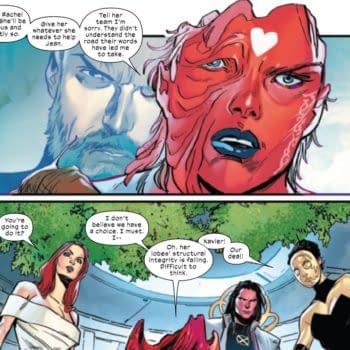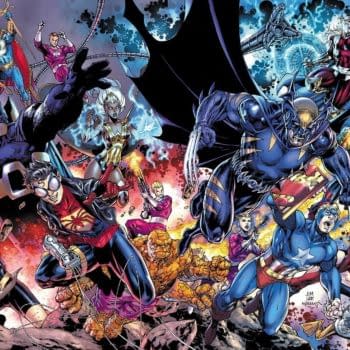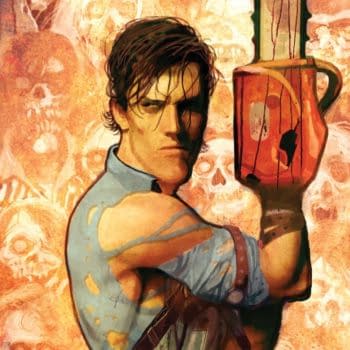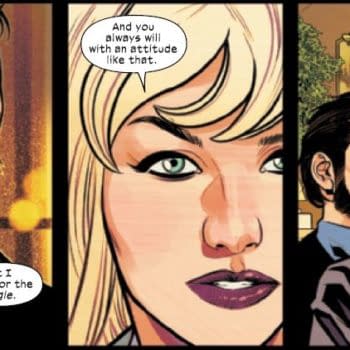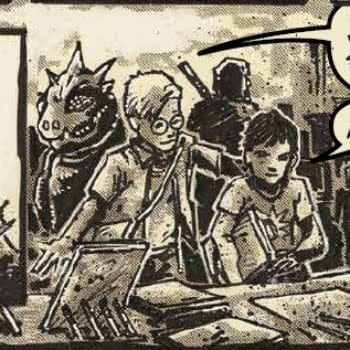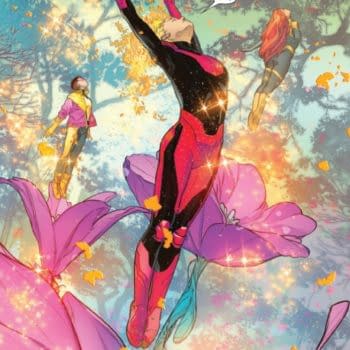Posted in: Look! It Moves! by Adi Tantimedh, Recent Updates | Tagged:
Look! It Moves! by Adi Tantimedh #14 – When The Angel Of Death Carries A Badge

Yes, Cooke is a brilliant cartoonist and storyteller with an expert's grasp of mood, tone, pacing and just how much or how little he needs to draw in a single image to tell his story, and THE HUNTER is as good as an adaptation of Richard Stark is likely to get, and as good an American comic is going to get, so my reservation isn't with the work itself but the hype heaped upon it. I don't think THE HUNTER is a step forward in crime comics because 1) it's an adaptation of a novel written in the 1960s, and 2) its look and tone are extremely retro in its depiction of old school pulp imagery in a partial throwback to EC's crime comics of the 1950s.. It's clearly Cooke's intention here, and he executes it superbly, but in the wider context of the medium, it looks backwards rather than forwards, and doesn't necessary push the medium or genre in new directions. There's nothing wrong with the book itself, I'll say it again: it's very good, but in a comics industry and culture where there's not much else in the crime genre that's stood out, I find it depressing that it gets held up as the Great Graphic Novel of the Year. In a healthier industry, it would still be a very good book, but not one that gets heralded as some kind of new innovation. European crime graphic novels have already been at it for decades. People have said my criticisms of recent crime comics are overly harsh, but I tend to hold things to the highest standards, and alas, I've been exposed to works of extremely high quality that beats most US material hands-down. I've been a regular reader of American, British, European and Japanese comics since early childhood, so I'm familiar with the differences in both storytelling technique and content. In the case of crime and noir comics, I'd already seen how high the bar can be set when I read a manga series from the 1990s that blew the hinges off the genre, and as far as I can tell, no other crime comic anywhere has approached its scope in form, ambition and content ever since.

JIRAISHIN (direct translation: EARTH, LIGHTNING, TREMOR) is a crime series with a deceptively and elegantly simple premise: a cop who hunts the worst, most twisted criminals who's even more dangerous and scary than they are.
Kyoya Ida is a detective in Tokyo's Shinjuku district. His father was a cop who accidentally shot a bystander and committed suicide from the guilt and shame, and the calm, unsmiling Ida is damaged and doomed. He's the Angel of Death with a badge, relentless and unstoppable when he's on a case. He's given up Love and sex and a family life. His face is set in an expression of grim blankness that, in shadow, can look downright murderous. His methods are cold, ruthless, calculating, and deadly. The delusional, the broken, the psychotic, the predatory, the outright psychopathic, these are his people. He looks them in the eye and challenges them to dance. He's good at catching them because he's just like them. The way he resolves most of his cases would land him in jail or a psych ward if the perpetrators weren't so heinous and his superiors didn't depend on him as their premier garbage man, the one who tackles cases no one else wants to touch. Apart from his single-minded pursuit of a case, he doesn't care if he lives or dies. He barely flinches when he's stabbed in the shoulder or when he puts his hand in the path of a razor to shield a teenage girl's face. When he's shown in a private moment towards the end of the series, he's sitting alone with a bottle of whiskey and a pack of cigarettes, shoulders hunched and face down, shut down, emptied out, a man who died inside a long time ago. There are no happy endings. The light at the end of the tunnel is the muzzle flash from Ida's gun as he shoots another perp in the head. This is Noir so dark you feel like you might drown in it.


Ida is asked by his chief to quietly investigate his daughter's fiancé before the wedding, and discovers the man committed a murder…
Ida pursues a pair of violent teenage lovers to China where a corrupt businesswoman is using them as pawns to secure a business contract with corrupt officials…

A Triad Queen arrives in Tokyo and threatens to kill a cop for each day they don't return her murdered sister's body, which places Ida and his partner Eriko in a dilemma, since she was the one who failed to save the sister…
An ex-con has to choose between going straight and taking up arms when the former Yakuza-turned-community-activist who took him in runs for office and faces revenge from their former victims. And Ida waits in the wings for the first shots to be fired…
In a story inspired by a real-life murder, a journalist creates a blog posing as a hidden, nameless girl who killed the mother that kept her prisoner all her life, setting off a media feeding frenzy and a teenage boy who takes up killing after identifying with the writing in the blog…
A burned-out war photographer returns to Japan and passively incites unstable people into committing acts of violence so he can be on hand to take photographs, trying to recapture the moment of death he experienced in war zones…
A psychopathic hitwoman discovers the donor of her new heart is the woman who loved and lost Ida, and becomes haunted by her emotions and memories. She goes on a murderous rampage to eliminate this "weakness" by targeting her family and eventually Ida, forcing him to face the existential abyss that passes for his life…

Interestingly, the closest parallel we've had to JIRAISHIN has been the recently-cancelled TV series LIFE, with its mysterious ex-con cop hero who's more dangerous than the perps he pursues. Like Ida, Charlie Crews is a killer with a badge. The only difference is that Crews hides his damage behind a cheery façade, and not even Crews is anywhere as dark or doomed as Ida.
And now, after spending the last ten years tackling Science Fiction, supernatural horror, sports, history, teenage dellquent and samurai manga, Takahashi has returned to the character that put him on the map and begun a sequel series JIRAISHIN DIABLO. Seven volumes have already been collected. I imagine enough fucked-up things have occurred in the interim for Takahashi to re-deploy Kyoya Ida, his angel of death with a badge. You can read fan translations of the complete run of the original series at places like One Manga.

This should conclude what's turned out to be a three-part discussion of the crime genre that I've been grappling with for the last few weeks. I'll probably go back to being snarky and frivolous about something else next week.
Not despairing, nope, not at all, at lookitmoves@gmail.com
© Adisakdi Tantimedh
Jiraishin © Tsutomu Takahashi and Kodansha Ltd.









